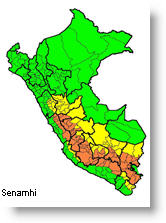Peru’s national weather bureau, Senamhi, has issued warnings of possible heavy rains and hailstorms this week in 11 regions of the central and southern Andes. Lightning and snow, and heavy winds, are also predicted for areas above 4,000 m (13,000 ft).
 A yellow or cautionary alert has been issued for heavy rains that are usual for this time of year, for the length of the central and southern cloud forest areas from Huanuco and Ancash to Cusco and Puno.
A yellow or cautionary alert has been issued for heavy rains that are usual for this time of year, for the length of the central and southern cloud forest areas from Huanuco and Ancash to Cusco and Puno.
The rains and storms in the Andean highlands, however, are expected to be more dangerous and Senamhi has put out an orange alert for Ancash, Huanuco, Lima, Junin, Pasco, Huancavelica, Apurimac, Ayacucho, Arequipa, Cusco and Puno. The Lima regions include the higher areas of Huaral, Oyon, Canta, Huarochirí and Yauyos.
The possible dangers are expected to abate by late Wednesday this week, reported Senamhi.
In Lima, rains and the increased humidity caused by the El Niño weather phenomenon have caused damages not only in the highlands – where 200 homes lost their roofs in San Bartolomé and the Santa Eulalia valley—but on the bare hillsides surrounding the city in the districts of Carabayllo, San Juan de Lurigancho, Villa María del Triunfo, Comas and Villa El Salvador.
In Collique, 150 houses have been structurally damaged from a mudslide and people are living in tents provided by civil defense, Indeci. Mud on the hillsides blocked the exit from a spiritual retreat of more than 100 members of an evangelical church. Police helped evacuate the children and pregnant women but the remainder decided to remain at the retreat until the following day.
President Alan Garcia visited the area with the mayor of Comas, Miguel Saldaña. The local government has designated an area for evacuees is receiving central government support in repairing access routes and basic services.
According to Raquel Loayza at Senamhi, the houses in the area are built poorly on the damp and overcrowded hillsides, causing critical stress on the terrain that can lead to more landslides if the rains continue.
State hospital doctors have reported an increase in respiratory ailments and are concerned that diarrhea and other infectious diseases may increase due to a lack of clean water.





